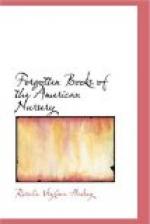In New York the Dutch element, until the advent of Garrat Noel, paid so little attention to the subject of juvenile literature that the popularity of Watts’s “Divine Songs” (issued by an Englishman) is well attested by the fact that at present it is one of the very few child’s books of any kind recorded as printed in that city before 1760. But in Boston, old Thomas Fleet, in 1741, saw the value of the element of some entertainment in connection with reading, and, when he published “The Parents’ Gift, containing a choice collection of God’s judgments and Mercies,” lives of the Evangelists, and other religious matter, he added a “variety of pleasant Pictures proper for the Entertainment of Children.” This is, perhaps, the first printed acknowledgment in America that pictures were commendable to parents because entertaining to their offspring. Such an idea put into words upon paper and advertised in so well-read a sheet as the “Boston Evening Post,” must surely have impressed fathers and mothers really solicitous for the family welfare and anxious to provide harmless pleasure. This pictorial element was further encouraged by Franklin, when, in 1747, he reprinted, probably for the first time in this country, “Dilworth’s New Guide to the English Tongue.” In this school-book, after the alphabets and spelling lessons, a special feature was introduced, that is, illustrated “Select Fables.” The cuts at the top of each fable possess an added interest from the supposition that they were engraved by the printer himself; and the constant use of the “Guide” by colonial school-masters and mistresses made their pupils unconsciously quite ready for more illustrated and fewer homiletic volumes.
Indeed, before the middle of the century pictures had become an accepted feature of the few juvenile books, and “The History of the Holy Jesus” versified for little ones was issued by at least two old Boston printers in 1747 and 1748 with more than a dozen cuts. Among the rare extant copies of this small chap-book is one that, although torn and disfigured by tiny fingers and the century and a half since it pleased its first owner, bears the personal touch of this inscription “Ebenezer ... Bought June ... 1749 ... price 0=2=d.” Was the price marked upon its page as a reminder that two shillings was a large price to pay for a boy’s book? Perhaps for this reason it received the careful handling that has enabled us to examine it, when so many of its contemporaries and successors have vanished.
The versified story, notwithstanding its quaintness of diction, begins with a dignified directness:
“The glorious blessed Time
had come,
The Father had decreed,
Jesus of Mary there
was born,
And in a Manger laid.”
At the end are two Hymns, entitled “Delight in the Lord Jesus,” and “Absence from Christ intolerable.” The final stanza is typical of one Puritan doctrine:
“The Devil throws his fiery
Darts,
And wicked Ones do act their
parts,
To ruin me when Christ is
gone,
And leaves me all alone.”




